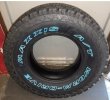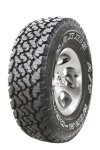As every one has said there is no tracking adjustment on the rear axle. There is no camber, there is no trail, its a solid bar with a wheel on each end.
The axle pivots on the A frame which is attached to the chassis and allows it to flex like a see saw.
To stop it moving backwards and forwards there are two, fixed length, rear radius arms which are bushed at the axle end near the outer ends, and forwards to the middle(ish) ot the chassis.
These allow the axle to move vertically on an arc
If the A frame pivot wears it would allow some rotational movement fore and aft and you hear this as a loudish clunk when changing from accelleration to braking.
The radius arm bushes can also wear and this allows some lateral rotation which is also noticable, but less so than the A frame.
The rear wheels are driven by half shafts that sit in hub stubs, which support bearing mounted wheels.
There is no opportunity for the rear wheels to develop camber unless a wheel bearing has failed which is more self evident than a worn tyre...
I run 35 to 40psi on road with my D90 and 15 to 20 off-road.
Occasionally I forget to pump-up.
It makes little difference to my tyre wear of mpg to be honest, but I am only going shortish distances and never on dual-carriage ways or at motorway speeds.

